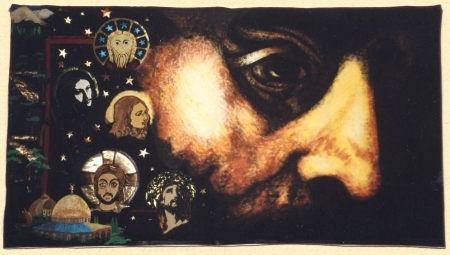| |
ust before
Lent ECVA artists were invited to observe Christ’s presence in
the world in which we find ourselves. Where might we see Christ
as he continues to be present with us through the worship of the
Church, our spiritual practices, our daily habits, our homes? As
the curator for this exhibition, Image and Likeness, I
too allowed this invitation to guide how I experienced the holy
season and I found myself pondering several questions: What role
does the image of Christ play in our understanding of Christian
discipleship? How do we learn to look for Christ in our lives?
And how does this practice of intentional observation affect how
Christ might be present not only in the things we observe but –
and perhaps more importantly – in ourselves? Is there a
reciprocal relationship between seeing Christ in others and
others seeing Christ in us?
| |
 |
| |
Judith McManis
Faces of Christ |
| |
|
The desire to
be in Christ’s presence is certainly nothing new. Indeed,
throughout the gospels people – believers and nonbelievers alike
– were drawn to his presence. Seeing him made a difference. In
the accounts of Christ’s Transfiguration we are told that Peter
offers to make three dwellings: one each for Christ, Moses and
Elijah whom Peter, John and James have witnessed gathered on top
of the mount. It’s easy for us to sneer at the naiveté of
Peter’s request, “Master, it is good for us to be here; let us
make three dwellings, one for you, one for Moses, and one for
Elijah…” Ridiculous! Of course Jesus could not let them make a
dwelling for him; he still had to get to Jerusalem. But we
should pause before being too judgmental of Peter.
Just prior to Luke’s account of the Transfiguration, Jesus asks
his disciples, “Who do you say that I am?” to which Peter
replies, “The Messiah of God.” Upon hearing this Jesus tells his
disciples, “If any want to become my followers, let them deny
themselves and take up their cross daily and follow me. For
those who want to save their life will lose it, and those who
lose their life for my sake will save it.” Only a week after
hearing these words Peter witnesses a glorified Jesus on the
mountaintop. Perhaps he felt a huge sense of relief as this
surely meant Jesus had come into his glory and no one was going
to have to figure out what in the world Jesus meant when he
talked about picking up a cross and losing one’s life. Peter’s
desire to make a dwelling for Christ perhaps came from his fear
that following Jesus might lead to an uncertain – perhaps even
deadly – destiny. “Stay here Jesus, and we will all stay here
with you and live in the presence of your glory… happily ever
after…,” Peter may have been thinking. But then the cloud
overcame them and a voice which said, “This is my Son, my
Chosen; listen to him,” which apparently silenced Peter and put
an end to his delusions of grandeur – for Christ and himself.
Death still loomed… the journey was not over.
We know what happens shortly after this scene. Jesus and his
disciples arrive in Jerusalem. Jesus is betrayed and handed over
to the authorities. Jesus is ridiculed, beaten and crucified.
And Peter denies that he even knows him – three times. If only
they would had stayed on the mountaintop…
During my Lenten reflections I found myself thinking of the
mysterious way Jesus continues to be present in the most
unlikely places. When you really think about it, the Church is a
rather odd place for God to be present. Why would a holy God
show up in the midst of sinners who gather every week with yet
another list of sins to confess? Why would he be present in the
mundane daily chores of changing diapers, washing dishes, doing
laundry? Why would he be present in the half-drunk beggar asking
for money right in front of my favorite dining place so that I
cannot avoid him nor can I overlook the fact that I’m about to
pay $10 for a burrito and a drink right after telling this man
“I don’t have any money”? I don’t know, but I’ve encountered
Jesus in all of these and while curating this exhibit I
discovered I’m not the only one.
 |
|
|
Susan Tilt
Transfiguration: Dwellings |
|
| |
|
Susan Tilt’s
Transfiguration: Dwellings was chosen for the “face” of
the exhibit because, apart from being a wonderfully executed
painting, it also resonated with the questions and issues I
grappled with while working on a vision for this exhibit called
“Image and Likeness.” For I believe we all, like Peter, desire
to see the glorified Christ and have him dwell with us – and he
does – just not always in the places we want or expect him. So,
like Peter, we are often puzzled by the places and ways Jesus
shows up to reveal God’s salvation. The artists represented in
this exhibition reveal the varied and apparently random ways
Jesus makes himself present in our lives. Some reflect
mountaintop experiences while some reflect the truth witnessed
on the cross. But they share the understated affirmation that
God continues to use artists to see and show the mysterious ways
Jesus participates in all aspects of our lives.
I hope you will enjoy the pieces, get to know the artists, and
feel free to drop a comment to them or myself if something here
resonates with wherever you are at in your journey with Christ.
It has been an honor to work on this exhibition and I cannot
thank ECVA enough for giving me the opportunity. I especially
want to thank Dan Hardison who realized my vision for the
exhibit with ease (seemingly) and enthusiasm.
Sincerely,

Carole Baker,
Curator |
|